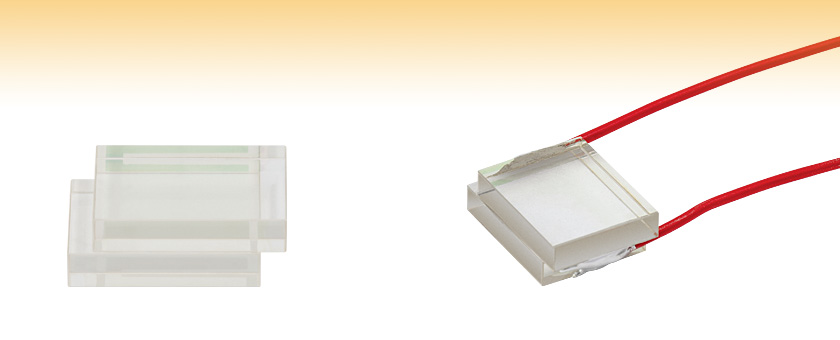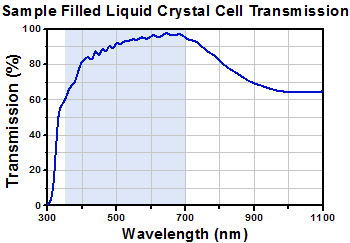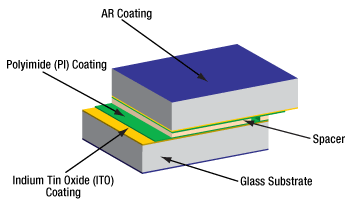液晶用セル、空容器

- Seven Different Cell Gaps
- Two Liquid Crystal Inject Holes
- AR Coating (350 - 700 nm) on Both Sides
LCC1312-A
LCC1318-A
Filled Cell with Wires Attached

Please Wait
特長
- 容器内の空洞寸法が異なる7種類のモデル
- 容器の外側両側に反射防止コーティング(350~700 nm)
- 酸化インジウムスズ(ITO)導電層(抵抗値は300~350 Ω/sq )
- 20 µmセル以外には、反平行なPI配向層
- ご要望に合わせて特注のセルもご提供可能(詳細は当社までお問い合わせください)
この液晶セルの空容器は、液晶材料や化合物の試験用に設計されています。 これらのセルには、酸化インジウムスズ(ITO)の導電層およびポリイミド(PI)の配向層があります(20 µmセルではPI層なし)。 7種類のセルでは、3 µm~20 µmの間隙に合わせて様々な寸法のスペーサも提供されており、研究室で簡単に液晶が注入できる設計です(「液晶注入とITO」のタブ内をご参照ください)。
この製品は可視域で高い透過率を達成するために、UV溶融石英(UVFS)ガラス、広帯域用反射防止コーティング、薄膜とITOが使用されています。他の波長領域に対応する液晶セルが必要であれば、特注セルもご提供できますのでご相談ください。
空容器の空隙の高さは3~10 µmで、液晶を反平行に配向するために、ラビング・組立されています。 LCC1324-Aの空隙高さは20 µmで、ポリミイド層はありません。 このセルは、高分子分散型液晶(PDLC)など、配向層を必要としない液晶材料向けに設計されています。 当社では、90°ツイスト配向や平行配向など他の配向方法に適したセル、そしてカスタム仕様のPI材料が使用できるセルもご提供できます。
当社ではAC電圧(0~25 Vrms)を印加しながらDCオフセットを補償する液晶コントローラLCC25およびKLC101をご用意しております。
| Item # | LCC1310-A | LCC1312-A | LCC1314-A | LCC1316-A | LCC1318-A | LCC1322-A | LCC1324-A |
|---|---|---|---|---|---|---|---|
| Cell Gap | 3 ± 0.3 µm | 4 ± 0.4 µm | 5 ± 0.5 µm | 6 ± 0.6 µm | 8 ± 0.8 µm | 10 ± 1 µm | 20 ± 2 µm |
| Cell Gap Uniformity | 5% over the Entire Clear Aperture | ||||||
| ITO Resistance (See Below) | 350 - 450 Ω/sq | ||||||
| AR Coating | Ravg <0.5%, 350 nm – 700 nm | ||||||
| External Dimensions | 17 ± 0.1 mm x 12 ± 0.1 mm x 6 ± 0.2 mm | ||||||
| Clear Aperture | 10 mm x 10 mm | ||||||
| Surface Quality | 40 -20 Scratch Dig | ||||||
| Surface Flatness | λ/10 @ 633 nm | ||||||
| PI Alignment | Anti-Parallel | N/A | |||||
| Glass Material | UV Grade Fused Silica | ||||||
シート抵抗
薄膜の抵抗値は、通常抵抗率(ρ)ではなく、シート抵抗(Rs)で表されます。 シート抵抗は、抵抗率(ρ)と薄膜厚さ(t)の比であると定義されます。単位はΩ/スクウェア(Ω/sq)となります。 シート抵抗の方が便利なパラメータであるのは、薄膜厚さが条件として加味され、薄膜の抵抗値を得るための寸法が2つしか必要ないからです(長さLと幅W)。この時、薄膜の抵抗値はR = Rs*L/Wで表すことができます。スクウェアにおいてはL = Wであるので、薄膜の平方面積当たりの抵抗値は、表面積の大きさに関係なく常に一定で、シート抵抗に等しくなります。 当社の液晶セルの寸法は12 mm x 15 mmであるので、実際の抵抗値は、シート抵抗の15/12倍となります。

Click to Enlarge
標準的なネマティック液晶材料を注入した液晶セルにおける無偏光の光の透過率
推奨される注入方法
毛細管現象を利用した注入
- 清浄な環境でセルを梱包材から取り出します。 いずれか1つの注入口に液晶材料をたらして、液晶材料がセルを満たすまで待ちます。 注意: 液晶材料の種類とセルの空隙寸法によって、注入の所要時間には10分から数時間のバラツキがでます。
- 液晶がセルを完全に満たしたことを確認して、2つの穴にUV硬化接着剤(NOA68など)を塗布して、接着剤を硬化して穴を封止します。 注意: ネマティック液晶材料を使う場合は、充填された材料を転移温度(液晶が等方性液体となる温度)より高い温度で2時間熱します。液晶の配向状態を均一にします。
真空室を利用した注入
- 清浄な環境でセルを梱包材から取り出します。 1つの穴にUV硬化接着剤(NOA68など)を塗布して、接着剤を硬化して穴を封止します。
- セルを真空室に入れて、セルの下に液晶の入った容器を置きます(ただしこの時点では、まだセルを液晶に浸けずに離した状態のままにします)。真空状態になった時にセルを液晶の中に浸漬できるような装置でセルを保持します。
- 真空室を排気して、気圧を10 Paまで下げた後に、真空室を液晶の転移温度を超えるまで熱します。
- 真空室が規定の気圧と温度になった後に、注入口が液晶に浸漬した状態になるまでセルを下げます。
- 真空室内を加圧すると、液晶がセル内に入ります。
- 時間をかけて温度を室温に戻します。
- セルを真空室から取り出して、もう1つの注入口にUV硬化接着剤を塗布し、接着剤を硬化することで穴を封止します。
電気的接続
上記のいずれかの方法で液晶を注入した後に、EG58などの導電性エポキシ接着剤を使用して、ワイヤを2本のITOストリップに接続してください。
| Posted Comments: | |
Abir Ahmed
(posted 2022-10-22 12:37:26.693) LCC25 Liquid Crystal Controller outputs a square wave only? Can I get triangular output?
I want to sweep -10V to +10V. cdolbashian
(posted 2022-10-31 01:14:42.0) Thank you for contacting Thorlabs. The output waveform of LCC25 only supports square wave. Derek G
(posted 2022-06-19 22:11:15.357) Can you make LC cells with any other thickness glass? I am hoping to image the liquid crystal inside of the cell and thick glass will make it hard to get good image quality and magnification without discussions a lot of money on new objectives. Any recommendations in case you cannot make a cell with thinner glass? Any advice on imaging through thick glass with relatively inexpensive objectives? Thanks cdolbashian
(posted 2022-06-24 03:57:34.0) Thank you for contacting Thorlabs. The LC cells with thinner glass would be a customized version, not a catalog product. Please feel free to contact us with your requirements at techsales@thorlabs.com to discuss this further. Linda Hirst
(posted 2022-02-09 20:00:10.953) I want to know how many cells we get for the price - its cant be just one?? cdolbashian
(posted 2022-02-14 01:32:32.0) Thank you for contacting Thorlabs. The catalog price is the unit price of one cell. Michael Rubal
(posted 2021-01-18 17:00:16.537) I was curious about the Empty Liquid Crystal Cells (ELCC). Most of my prior work has invovled the anlaysis of thermotropic liquid crystals and lyotropic liquid cystals by polarized optical micrscopy. I would like to explore using your ELCC, but had a few basic questions:
1) Can you use the ELCC on a standard microscope stage with polarizers?
2) What is the simplest controller you need for this? I was primarly interested in DC voltage changes. I assume I could sinply add a power source with controlled voltage (ie battery).
3) Can these cells be reusable?
Thank you for your time,
Mike Rubal YLohia
(posted 2021-01-22 11:53:49.0) Thank you for contacting Thorlabs. 1) You can certainly use the ELCC with polarizers, but we may or may not have a mounting solution for that based on your microscope's requirements. 2) We recommend using a controller that can supply an AC signal similar to that of our LCC25. We suggest using a square waveform drive for stable operation. Output Voltage Adjustment Range: ± 25 VAC (f = 2kHz, 2kHz is the default frequency of LCC25, other frequencies may be applied if a custom driver is used.) Max Output Current: 15 mA. Please note that there should not be any DC offset as this can build up charge and damage the liquid crystal device. 3) Theoretically the cell can be re-used, however, it's not easy to remove all the LC material, so re-use is not recommended. Paul Cain
(posted 2020-03-11 10:43:50.257) What sort of applications are the Empty Liquid Crystal cells used for?
thank you,
Paul YLohia
(posted 2020-03-12 08:25:04.0) Hello Paul, thank you for contacting Thorlabs. The Empty Liquid Crystal Cells are designed for testing liquid crystal compounds and materials. A typical application is to make liquid crystal devices such as variable retarders : https://www.thorlabs.com/navigation.cfm?guide_id=2258. Nils Maasjost
(posted 2019-04-10 03:43:28.04) Good morning,
I've purchased LC-Cells and now trying to connect the cabels with the cell, but the suggested method of using EG58 led to a mess. Additionally I can't see out of the specs sheet, where I should connect the cabels. Could you give me any recommidations in this regard?
Best regards
Nils Maasjost nbayconich
(posted 2019-04-12 03:06:27.0) Thank you for contacting Thorlabs. There is about a 2mm width layer of exposed ITO coating to apply the wire leads to. Please see the example drawing in the link below, the best way to connect your wire leads is to place them as close to the edge of the substrate as possible to avoid contact with the PI layer.
https://www.thorlabs.us/images/TabImages/Liquid_Crystal_Cell_D1-780.gif Maoqi.Lin
(posted 2019-01-22 14:02:09.307) Hi, I am very interested in purchasing these liquid crystal cells. Are they reusable?
Also, in terms of the liquid crystal controller, since it is a little over budget for me, can I simply use any other AC power suppliers which manages the voltage, current and frequency? Many thanks nbayconich
(posted 2019-01-24 11:22:03.0) Thank you for contacting Thorlabs. Theoretically the cell can be re-used, however, it's not easy to remove all the liquid crystal material,and we have no suggested method to remove it, so re-use is not recommended.
For third party controllers, we recommend using a controller that can supply an AC current similar to our LCC25 controllers specifications. We suggest you use a square wave form driving signal for stable operation.
Output Voltage Adjustment Range: ± 25 VAC (f = 2000 ± 5 Hz)
Max Output Current: 15 mA
Please note that there should not be any DC offset as this can build up charge and damage the liquid crystal device, as stated in LCC25’s description:
“The DC offset compensation automatically zeroes the DC bias across the LC device in order to counteract the buildup of charges, and avoid damage to the LC device.” 381529773
(posted 2018-11-16 21:49:19.003) Dear thorlabs,
I want konw the material of the spacers in the cell,does it a thin film and distributes all over the cell?And if it scatter or absorb light? nbayconich
(posted 2018-11-20 08:29:01.0) Thank you for contacting Thorlabs. The spacers we use in our LCC products are little balls blended with specific glue which are on the substrates’ edges, which will not interfere with the cell surface as to cause scattering or absorption within the clear aperture. zhangyongbin2015
(posted 2018-09-29 11:06:24.943) Dear, we want to know the maximum permitted thickness of the liquid layer with the preferential orientation if customizing a cell. Can you suggest the maximum thickness of the liquid crystal to me? Thank you very much. YLohia
(posted 2018-10-22 02:37:51.0) The largest thickness of LC cell we can offer is 50um. Would you be able to explain what you mean by “ensure the preferential orientation”? Please reach out to us at techsupport.cn@thorlabs.com. zhangyongbin2015
(posted 2018-09-29 10:48:29.8) Dear, we want to investigate the nonlinear phenomenon of the nematic liquid crystals. In order to have a macroscopic order, the liquid crystals is needed to be integrated into a cell. We want to know the maximum permitted thickness (important) of the liquid layer? Or if you have any method to achieve a test of a thick liquid sample and ensure the preferential orientation? Thank you. mariachiara.ubaldi
(posted 2018-05-09 15:23:31.75) Dear Thorlabs
I have three of your cells and would like to use one of them for characterization purposes by splitting the glasses+ITO+polymmide apart.
Can you suggest me how to do this?
Best regards
Maria Chiara Ubaldi nbayconich
(posted 2018-05-14 08:18:52.0) Thank you for contacting Thorlabs. The coatings cannot be removed from the finished product but we can possibly provide a customized version without the coating layers you do not require. I will reach out to you directly with more information about our custom capabilities. mariachiara.ubaldi
(posted 2018-02-09 15:45:19.16) Dear Thorlabs
I have one of your cells filled up with liquid crystal and I have to perform ellipsometric measurements. First of all I'd like to know how glass AR coating is made (layers and thickness) in order to insert it in my model.
Besides, have you ever performed full ellipsometric characterization of your cell filled with std liquid crystal? Considering AR and ITO and LC birefringence is a har model to build up.
Best regards
Maria Chiara llamb
(posted 2018-04-03 03:56:31.0) Hello Maria, thank you for contacting Thorlabs. Our AR coating information is proprietary and we do not currently have full-scale testing done on the ellipticity of light through the cells. I will contact you directly to discuss typical cases of ellipticity. mariachiara.ubaldi
(posted 2017-03-20 14:12:15.863) Dear sirs
I encountered issues in filling the cell with a nematic crystal, with low viscosity. I apply a drop onto the filling port, but the gap never fills for capillarity effects, but seems to stay on the top of the port. I cannot use vacuum chamber.
Can you suggest me a solution?
Best regards
Maria Chiara tfrisch
(posted 2017-03-30 02:03:24.0) Hello, thank you for contacting Thorlabs. I will reach out to you directly with my inquiries about your setup and what cell you are using. souravpatranabish
(posted 2016-09-12 15:34:16.847) Can you please let me know that how many empty liquid crystal cells you provide in each unit of the product? Also kindly inform whether the cells have planar (homogeneous) alignment. Thank you. tfrisch
(posted 2016-09-15 01:28:37.0) Hello, thank you for contacting Thorlabs. The cells do have a planar (homogeneous) alignment. Each unit is once empty cell. I have reached out to you directly if you have further questions. milankie
(posted 2016-03-17 13:00:41.68) I am also interested in the damage threshold of the liquid crystals. besembeson
(posted 2016-03-17 02:35:49.0) Response from Bweh at Thorlabs USA: I will contact you about your laser characteristics, as we have not established these values yet. patricio_romero
(posted 2016-02-24 14:08:01.227) The ITO electrodes have a shape? are they a square/rectangle etched electrode? or is deposited all over the glass surface?
Is this glass adequate for Raman measurements? from glass fluorescence point of view?
Is it possible to get other electrodes materials like gold? (~10 nm sputtered gold is still viewable-through under POM) besembeson
(posted 2016-03-08 02:15:26.0) Response from Bweh at Thorlabs USA: The ITO is deposited all over the glass surface. I will contact you regarding your Raman application and the custom cell. mccamyjw
(posted 2015-09-23 14:02:29.763) This is potentially a very interesting experiment for the classroom and my kids. Can you recommend a specific LC material (and perhaps a source)? Or is there a source that sells this as a kit? Finally, is there an easy way to remove the LC after the demo to reuse the unit to try others and/or another class?
Thanks very much
Jim besembeson
(posted 2015-10-01 03:09:40.0) Response from Bweh at Thorlabs USA: We can recommend a liquid crystal named 5CB which has a simple molecule structure and low clearing point. It is commonly used for demonstration and educational purpose. You can check with material vendors like HCCH or Merck regarding acquiring these. Our current device structure makes it impossible to remove LC and re-introduce another. Even if we make a customized cell to do it, it will still be a complicated process to draw the LC out, and the result is difficult to predict. johnnysheng
(posted 2015-01-30 10:46:18.633) What is the laser damage threshold at, e.g., 450nm?
Is the PI layer inorganic? jlow
(posted 2015-01-30 04:37:50.0) Response from Jeremy at Thorlabs: The PI layer is polyimide, which is organic. We do not have a damage threshold specification for this at the moment. I will contact you directly to discuss about this further. |
 Products Home
Products Home






 液晶用セル、空容器
液晶用セル、空容器